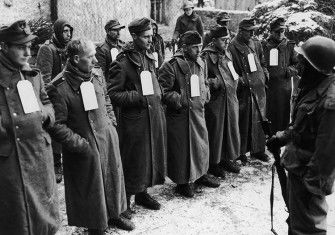War is Hell
A visceral history of of American soldiers in Belgium, France and Italy, 1943-45.

‘It is absurd to believe that soldiers who cannot be made to wear the proper uniform can be induced to move forward in battle.’ For General George Patton, leader of the US Third Army in the Second World War, cleanliness and discipline were inextricably linked. A clean and tidy appearance spoke to order and obedience; a slovenly, unshaven soldier was a mutinous degenerate doomed to lose.
Patton’s furious attack on the American cartoonist Bill Mauldin, whose drawings of GIs Willie and Joe had offended the general with their scruffy, mud-streaked appearance, forms one of the most engaging essays at the heart of Sheer Misery. Mary Louise Roberts sets out to provide a ‘somatic history’ of the Second World War, a conflict more usually discussed in terms of high-level military strategy and sanctified in popular memory as a ‘good war’. Using the letters and diaries of (primarily American) soldiers fighting in Belgium, France and Italy during 1943-45, alongside other sources such as army training manuals and newspapers, Roberts creates a visceral history of what it actually felt like to the men taking part in these campaigns, which she describes as ‘the high-water marks of infantry misery’.
The book is described as a ‘loosely-structured set of essays’, but a recurring theme is the clash between the way in which commanders such as Patton thought about and deployed men’s bodies, expecting them to behave as they had in training, and the lived experience of those on the frontline. Mauldin’s cartoons admitted that the standards of cleanliness and physical discipline soldiers were held to in the controlled environment of the training ground were almost impossible to maintain in the brutal reality of extreme cold, or thigh-deep mud and torrential rain, where there was no hope of dry – let alone warm – feet. Roberts takes a similar line, showing the stark contrast between the expectations of Allied commanders and officers at the rear and the wretched existence of men at the front, whose undernourished and exhausted bodies endured not only brutal winters, but also a bombardment of sights, sounds and smells that was utterly overwhelming. This disconnect is explored as an empathy deficit on the part of commanding officers, an argument at its most persuasive when 20,000 GIs hospitalised with trench foot were blamed for causing the condition through ‘poor foot discipline’, rather than the appalling conditions, poor-quality footwear and paucity of dry socks.
There are some intriguing diversions to topics such as superstition and premonition among frontline soldiers, as well as the important and complex subject of ‘war neuroses’, and it is a shame that these are not developed further. However, Sheer Misery is at its most compelling when the bodily experiences of American and British infantrymen are being examined and the sources used are wonderfully rich. By supplementing them with those of French and occasionally German troops, Roberts shows that the ways in which infantrymen experienced and made sense of their punishing lives on the front line were common across the conflict. This commonality is humanising and again allows the individual to emerge from behind the tables of statistics or tales of battles lost or won. The reader is given a vivid sense of what it was like to endure a bombardment, see a dead body for the first time or suffer a wound and its subsequent treatment. By focusing on the everyday misery of the unwashed men on the ground, this study provides a timely reminder that, in the words of another US General, ‘war is hell’.
Sheer Misery: Soldiers in Battle in WWII
Mary Louise Roberts
University of Chicago Press 208pp £19
Susanna Shapland is history correspondent for Community Living.






